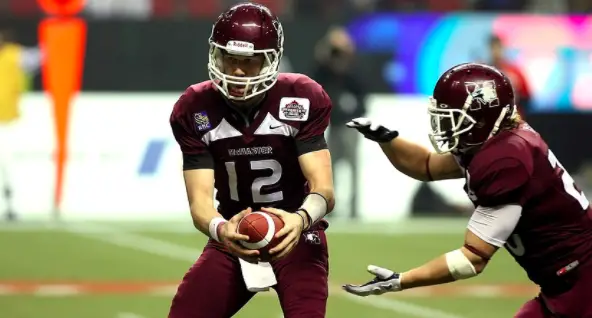The term RPO stands for run pass option. An RPO in football is a play that allows the quarterback to make the decision to hand the ball off or pass it. Typically these plays are run first meaning it will be a handoff unless the quarterback decides to opt for a pass instead.
The offense on an RPO will usually stay in run blocking as these plays most often end in runs. This means the pass options on RPOs are quick as the quarterback doesn’t typically have much time in the pocket.
Who invented the RPO in football?
Joe Tiller – Purdue
Coach Joe Tiller of Purdue is one of the coaches that has been argued to have created the RPO. Though, similar to musicians accidentally writing the same riff the RPO has actually been “invented” by several different players and coaches.
The earliest form of the RPO we found was with Joe Tiller and Drew Brees at Purdue University. They built the first RPO out of reacting to an outside linebacker. If the linebacker lined up inside the slot receiver then Brees would throw a bubble screen out wide. If the linebacker lined up outside the slot receiver then Brees would hand the ball off.
This read was done pre-snap which makes it slightly different from the modern RPO which makes the read during the play.
Brett Favre – Green Bay
Another potential inventor of the RPO was Brett Favre. In an episode of Gruden’s QB camp Favre went on to explain how he also accidentally invented the RPO.
Favre explains how he noticed on some running plays that his receiver on the opposite side of the field were wide open. On these plays, he would read the corner who would often give the receiver a massive cushion.
On these plays, Favre told the receiver to run a one-step slant. If the corner left the receiver open Favre would abandon the run and make a quick throw.
In the video, Favre states that this was under coach Mike Sherman who didn’t coach the packers until the early 2000s. This means that Favre’s revelation did not come until Purdue had already been running that offense for years.
Art Briles – Stephenville Texas
Another so-called “invention” of the RPO occurred at Stephensville high in Texas. This team ran a triple-option offense and upon switching to the wishbone offense Art Briles decided to keep some of the option methods intact.
This RPO offense was primarily done in the redzone and relied on reading the safety. In a redzone situation the safety did not have enough space to disguise his assignment. This allowed the quarterback to make an easy read and choose run or pass based on the play of the safety.
How To Defend It
When a team runs an RPO Offense they are looking to read a single player on the defense and react. This player on the defensive is referred to as an overlap player. Meaning he has responsibilities in the run game as well as the passing game.
Say for example it is a weakside linebacker. This linebacker will be responsible for a gap to stop the running back as well as a zone coverage assignment. If you remember earlier we stated that RPO’s typically feature the lineman run blocking.
When the linebacker sees this he will go to fill his gap and leave his zone uncovered. If he goes to the zone they will simply run through his gap.
To stop this on defense you must first identify the gap player in which the offense is exposing. At this point, you must work to assign other defensive players to fill his gap.
If you have another play fill the run gap or cover the zone you will allow the linebacker to focus on a single responsibility.
This may leave a hole in a different part of your defence but will allow your linebacker to effectively play his given role.
Benefits Of The RPO

One of the biggest benefits of using the run pass option in football is that it presents an easy read for the quarterback. Many offensive plays in football require a large amount of thinking from the qb and the defense knows this.
Defenses at high levels of football will confuse the quarterback with their coverages baiting him into making the wrong decision.
With the RPO a quarterback will not have to worry about making difficult reads as he must only read a single player. This makes this offensive concept easy to run for any quarterback.
This can be helpful when using a quarterback who has had little time to prepare for a game.
Additionally RPOs are going to allow the offense to pass the ball off quickly. If a teams offensive line is struggling in pass protection an RPO can be a handy tool to get the ball out quick.
Since the quarterback only has a single player to read he will not be spending a lot of time in the pocket.
This should allow the quarterback to reduce the number of sacks he takes.
Finally, an RPO is going to make it difficult on the defense by using both passing and running concepts. On each play, many players have both run game and passing game responsibilities.
By making them choose between the two you may find some defenders will be out of position.
The quarterback typically only reads a single player but many players on the defense will have to read the quarterback during the play to find out what defensive role they have to play.
If this leads to even a one-second hesitation by a defending player this could be enough to allow the quarterback to take off running right through that player’s gap.
That’s all on RPOs in football to learn about other football strategies and concepts see our guide to learning gaps or learn what a sail concept is in football.

